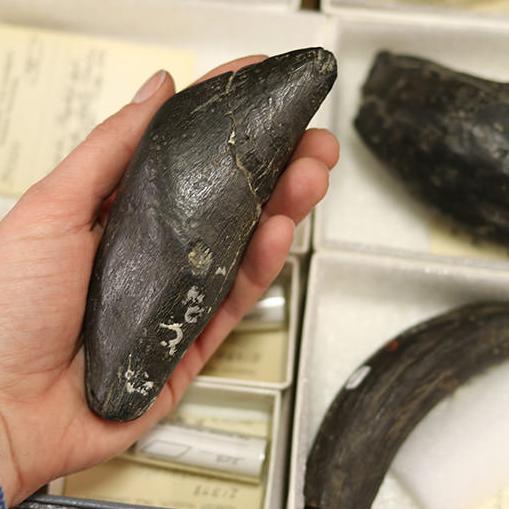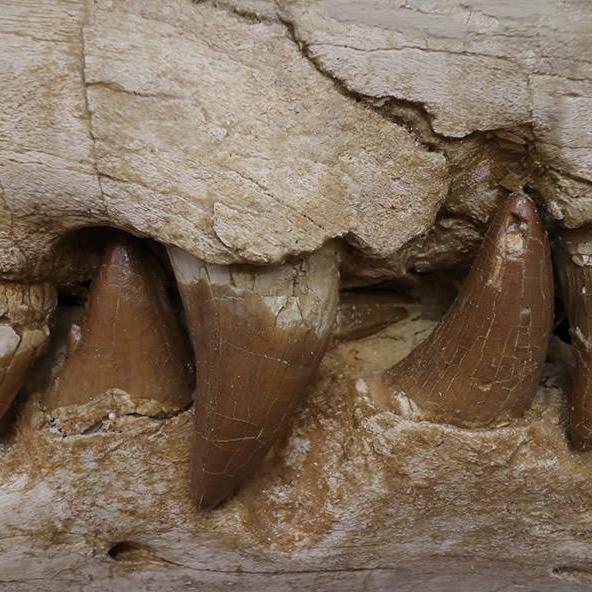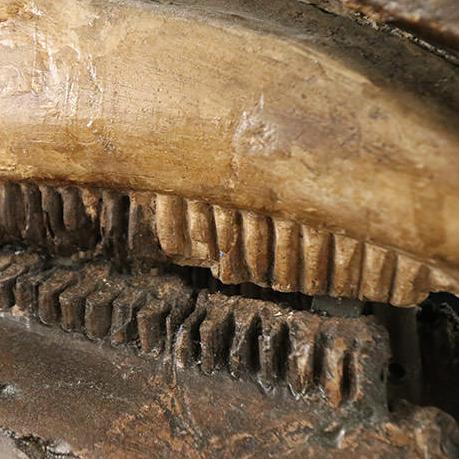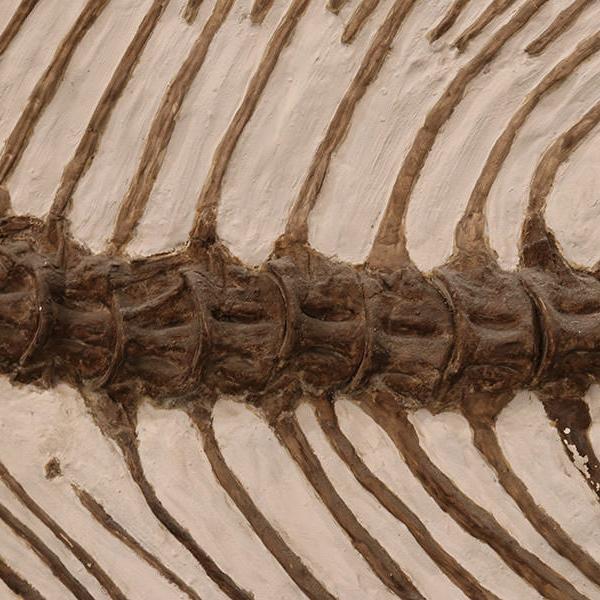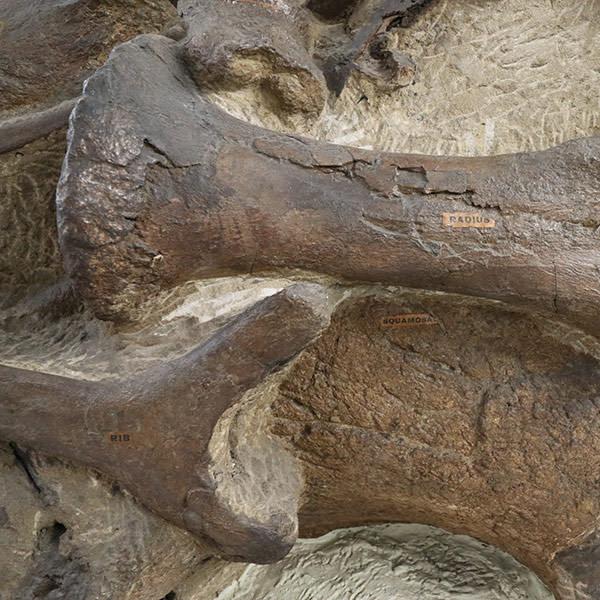Search the Collection
The Yale Peabody Museum’s Division of Vertebrate Paleontology houses one of the oldest and most important vertebrate fossil and ichnofossil collections in North America. Begun in the 1850s by Othniel Charles Marsh, the first professor of paleontology in the United States, they continue to grow in size and scope into the 21st century through the efforts of Yale faculty curators, students, and affiliates.
The geographic scope of the Peabody vertebrate paleontology collections is worldwide. Its taxonomic breadth includes every vertebrate class, from the Ordovician to the Holocene. With the acquisition of the Princeton University Collection in 1985, which added nearly 20,000 specimens, the Division today boasts over 80,000 catalogued specimens, including nearly 5,000 types.
Select highlights of the fossil vertebrate collections include:
- Ordovician agnathans from the Harding Sandstone of Colorado and Wyoming.
- Devonian fish from the Cleveland Shales of Ohio.
- Pennsylvanian amphibians from Mazon Creek, Illinois.
- Limnoscelis paludis from the Permian of New Mexico and Eryops megacephalus from the Permian of Oklahoma and Texas.
- Triassic fish, tetrapods, and footprints from the Newark Group of Connecticut, Massachusetts, and New Jersey.
- Triassic archosaurs from Arizona, New Mexico, and Utah.
- Ichthyosaurs from the Jurassic Lower Lias of Lyme Regis, England.
- Iconic dinosaur taxa from Cañon City and Garden Park, Colorado, as well as Como Bluff, Wyoming, from the Jurassic Hell Creek Formation, Jurassic Morrison Formation, and Cretaceous Lance Formation. Notable genera include Brontosaurus, Camarasaurus, Camptosaurus, Edmontosaurus, Stegosaurus, Torosaurus, and Triceratops.
- Archelon ischyros from the Cretaceous Pierre Shale of South Dakota.
- Mesozoic mammals.
- Late Cretaceous and early Paleocene vertebrates from the K-Pg boundary of Montana, including Camel Butte, Hoff Ranch, and Wang Ranch.
- Xiphactinus, turtles, pterosaurs, crocodiles, mosasaurs, Claosaurus, and toothed birds (Hesperornis and Ichthyornis) from the Cretaceous Niobrara Formation of Kansas.
- North and South American tertiary mammals.
- Eocene mammals and lower vertebrates from the Bighorn Basin of Wyoming.
- Eocene and Oligocene mammals from the Fayum of Egypt.
- Siwalik mammals from northern India and Pakistan.
With the establishment of the Peabody Museum in 1866, its growing vertebrate fossil collections at Yale became a hub for research on the history of life. This fueled intensive paleontological investigations in the late 19th century. Beyond the pioneering collecting by O.C. Marsh, significant contributions were made by “professional collectors” and “assistants” such as Erwin H. Barbour, David Baldwin, George Baur, Charles Emerson Beecher, Hugh Gibb, George Bird Grinnell, Oscar Harger, John Bell Hatcher, Marshall P. Felch, Arthur Lakes, Otto Meyer, Benjamin Mudge, O.A. Peterson, William Reed, George R. Wieland, and Samuel Wendell Williston.
In 1906 Richard Swann Lull revived the active collecting program started by Marsh. In 1926 Lull’s tenure saw the transition from the Museum’s first building in downtown New Haven to the present-day Peabody. Lull was closely involved in preparing exhibitions that became the backbone of the Great Hall, including the debut of newly mounted skeletons and his signature flesh reconstructions of prehistoric organisms. In 1936 Lull was succeeded by G. Edward Lewis, who renewed the emphasis on field collecting.
Paleontology at Yale greatly expanded in the last half of the 20th century through the efforts of curators Elwyn L. Simons, John H. Ostrom, Alfred W. Crompton, Keith S. Thomson, David Archibald, and David Pilbeam. Ostrom’s research and writings on the functional morphology of dinosaurs and the evolution of birds was the main impetus behind the “dinosaur renaissance.” His work resulted in the discovery of important new dinosaurs, including Tenontosaurus tilletti, Sauropelta edwardsi, and, most famously, Deinonychus antirrhopus. Active field programs today in the Triassic of Arizona and the K-Pg boundary of Montana continue to build a diversity of vertebrate faunas for ongoing research and public display.
Peabody Expeditions
The Yale Peabody Museum has a long history of mounting expeditions to the far corners of this world. Between 1870 and 1873, O.C. Marsh led 4 Yale College Scientific Expeditions of students into the American West. Other land and marine expeditions have added significantly to the holdings of the Museum throughout its history.
The O.C. Marsh Papers
The historically and scientifically important specimens and materials assembled by Othniel Charles Marsh are preserved at the Peabody. The O.C. Marsh Papers, available at the Yale University Library Manuscripts & Archives, is an invaluable corollary archive of correspondence, diaries, notebooks, family papers and related materials.
Research in the Vertebrate Paleontology Collections
The Peabody’s curatorial divisions are governed by the Museum’s collections policies and best practices document. Collections are available to researchers for scholarly use and loans are issued to individuals at established institutions. Loans and access can be arranged through the curatorial division’s collections manager.
|
Vanessa Rhue
Collection Manager,
Vertebrate Paleontology
+1 203 432 3748
vanessa.rhue@yale.edu
|
The Division of Vertebrate Paleontology supports research by faculty, affiliates, staff, and students in vertebrate systematics, evolution, and paleobiology, as well as field collecting programs in the western United States. Staff in our Vertebrate Paleontology Laboratory prepare and conserve specimens for research and exhibition. In-house expertise, facilities, and instruments allow for a suite of preparation methods and analytical imaging techniques, including mechanical preparation, air abrasion, molding and casting, histology, micro-computed tomography scanning, scanning electron microscopy, digital photography, photogrammetry, and surface scanning.
The Bulletin of the Peabody Museum of Natural History, Yale University, publishes original research in the natural science disciplines represented by the collections of the Yale Peabody Museum’s curatorial divisions.
